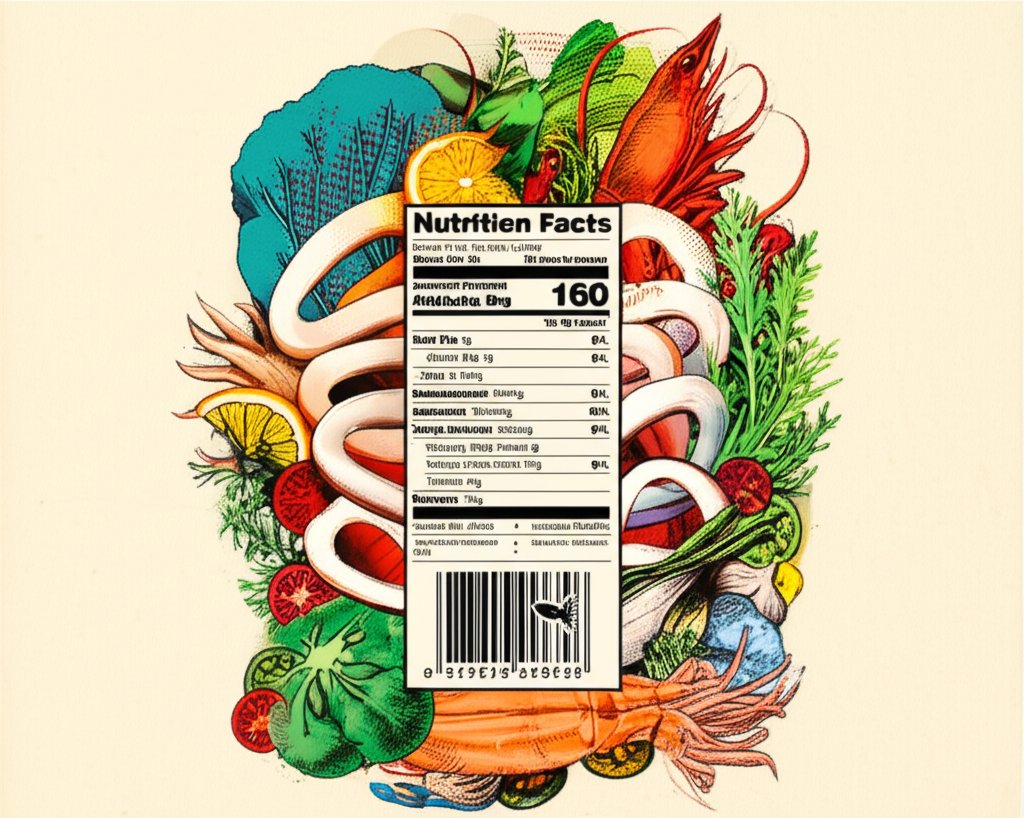Untuk gambaran yang lebih besar dan konteks penuh, pastikan Anda membaca panduan utama kami tentang Smoke Salmon Nutrition Facts: Health Benefits and Risks to Know.
markdown
Squid Nutrition Facts: A Deep Dive Into Calamari’s Goodness

Think of smoked salmon, with its rich omega-3s and protein, as a nutritional powerhouse from the sea. But what about other seafood options? While often overlooked, exploring squid nutrition facts reveals a surprisingly healthy alternative, especially when considering variety and dietary needs. Can calamari stand toe-to-toe with smoked salmon? Let’s dive in.
At a glance:
- Uncover the detailed nutritional profile of squid (calamari).
- Compare squid’s benefits with those of smoked salmon.
- Learn how to prepare squid to maximize its health benefits.
- Address common concerns about cholesterol and mercury in squid.
- Discover simple ways to incorporate squid into your diet.
Decoding Squid Nutrition: More Than Just Fried Rings
Often, our first encounter with squid is the deep-fried calamari appetizer. However, this preparation method masks the inherent nutritional value of the squid itself. Let’s look beyond the batter and oil.
A 3-ounce (85-gram) serving of raw squid provides approximately:
- Calories: 70-80
- Protein: 13-16 grams (a significant source of lean protein)
- Fat: 1-2 grams (mostly unsaturated fats)
- Carbohydrates: Minimal
- Cholesterol: 150-200mg (more on this later)
- Vitamin B12: High levels, essential for nerve function (like smoked salmon).
- Selenium: An antioxidant that supports immune health.
- Copper: Important for iron absorption and enzyme function.
- Riboflavin (Vitamin B2): Aids in energy production.
Unlike smoked salmon, squid contains very little sodium naturally. This makes it a great option for those watching their sodium intake. However, preparation methods can quickly change this.
Squid vs. Smoked Salmon: Key Nutritional Differences
Smoked salmon is hailed for its omega-3 fatty acids, especially EPA and DHA, which are vital for heart and brain health. You can Learn about smoked salmon and its amazing benefits. Squid, while containing some omega-3s, is not as rich a source as salmon.
Here’s a quick comparison table:
| Nutrient | Squid (3 oz, raw) | Smoked Salmon (3 oz) |
|---|---|---|
| Protein | 13-16g | ~18g |
| Omega-3 Fatty Acids | Lower | High |
| Sodium | Very Low | High |
| Cholesterol | Higher | Moderate |
| Vitamin B12 | High | Very High |
| The Bottom Line: Smoked salmon excels in omega-3s and vitamin D, while squid offers a lean protein source with lower sodium. Both provide valuable nutrients. |
Demystifying Squid’s Cholesterol Content
One of the biggest concerns surrounding squid is its cholesterol content. Yes, it’s relatively high compared to other seafood. However, dietary cholesterol doesn’t necessarily translate to elevated blood cholesterol in most people.
- The Myth: Eating high-cholesterol foods automatically raises your blood cholesterol.
- The Reality: For most, saturated and trans fats have a greater impact on blood cholesterol levels.
Studies suggest that for many individuals, the body regulates cholesterol production, and dietary cholesterol has a limited effect on blood levels. People with specific conditions, such as familial hypercholesterolemia, may need to be more cautious.
Actionable Tip: If you’re concerned about cholesterol, discuss it with your doctor. Enjoy squid in moderation as part of a balanced diet low in saturated and trans fats.
Smart Squid Prep: Maximizing Benefits, Minimizing Risks
How you prepare squid significantly impacts its nutritional profile. Frying adds unnecessary calories and unhealthy fats.
Better Cooking Methods:
- Grilling: Quick and easy, retains the squid’s natural flavor.
- Steaming: Preserves nutrients and keeps the squid tender.
- Stir-Frying: Use minimal oil and lots of vegetables.
- Boiling/Simmering: Great for adding to soups and stews.
Recipe Snippet: Grilled Squid Salad
- Marinate squid in olive oil, lemon juice, garlic, and herbs for 30 minutes.
- Grill for 2-3 minutes per side until cooked through.
- Toss with mixed greens, cherry tomatoes, cucumbers, and a light vinaigrette.
This salad provides a lean protein boost with a dose of vitamins and antioxidants.
Mercury Levels: A Balanced Perspective
Like many seafood options, squid contains mercury. However, it’s generally considered to be low in mercury.
- EPA and FDA Recommendations: Advise consuming a variety of seafood while being mindful of mercury levels, especially for pregnant women, nursing mothers, and young children.
- Squid Position: Typically falls into the “best choices” category, meaning 2-3 servings per week are generally considered safe.
Practical Step: Consult the FDA’s seafood consumption guidelines for the most up-to-date recommendations.
Quick Answers: Squid Nutrition FAQs
- Is squid high in fat? No, raw squid is very low in fat, mostly unsaturated. The fat content increases significantly when fried.
- Can I eat squid if I have high blood pressure? Yes, as long as it’s prepared without excessive salt. Squid itself is naturally low in sodium.
- Is calamari good for weight loss? It can be! Squid is a lean protein source that can help you feel full and satisfied. Choose healthy cooking methods.
- Does squid have omega-3 fatty acids? Yes, but not as much as fatty fish like salmon.
- Is squid a good source of protein? Absolutely. One serving provides a substantial amount of lean protein.
Actionable Integration: A Squid Nutrition Quick Start
Ready to incorporate squid into your diet? Here’s a quick-start guide:
- Start Simple: Buy fresh or frozen squid tubes (bodies) and tentacles.
- Master a Quick Recipe: Try the grilled squid salad or a simple stir-fry.
- Prioritize Healthy Prep: Avoid deep-frying. Opt for grilling, steaming, or stir-frying.
- Watch the Salt: Be mindful of added sodium, especially in sauces and marinades.
- Enjoy in Moderation: Incorporate squid into a balanced diet with a variety of other seafood and protein sources.
- Check for Allergies As with any seafood, be aware of potential allergies.
By understanding squid nutrition facts and choosing healthy preparation methods, you can enjoy this versatile seafood as a valuable addition to your diet. It offers a lean protein alternative with unique nutritional benefits that complement the already impressive profile of options like smoked salmon.
- How Glass Bento Box Containers Make Meal Prep Easier - December 18, 2025
- Why Glass Boxes for Lunch Are Trending for Meal Prep - December 17, 2025
- Bento Box Glass Offers Practical, Eco-Friendly Meal Storage - December 16, 2025










